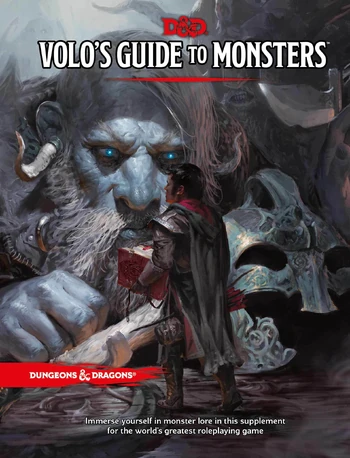
I actually finished reading the entirety of Volo's Guide to Monsters last night, and... I don't think I'll be adding too much to the other races expanded upon in Volo's? A lot of the new cultural aspects to, like, orcs and gnolls and giants and kobolds and whatnot sort of get wrapped up in the new variants introduced here, and the other aspects of their culture is... well, I'm not going to break down every single minutiae about the book, yeah? I mean, it's actually a pretty great read, and I do encourage you guys to look it up for your own if you're interested in D&D monster lore. I sure am!
- Click here for the first part of Volo's, covering Banderhobb to Froghemoth.
- Click here for the second part of Volo's, covering Nilbog to Yuan-ti variants.
- Click here for the index.
________________________________________
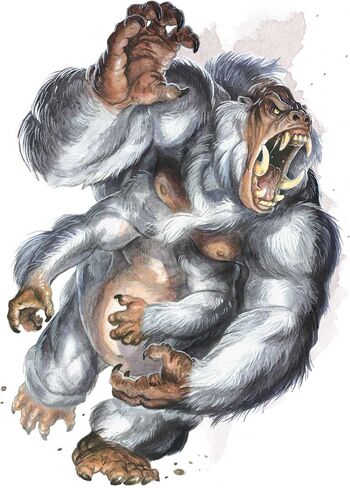
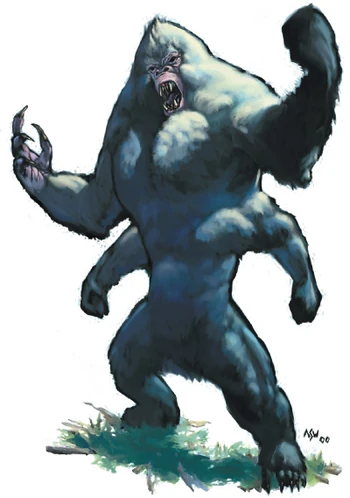
Girallon
- 5.5E/5E: Large Monstrosity; Unaligned; CR 4
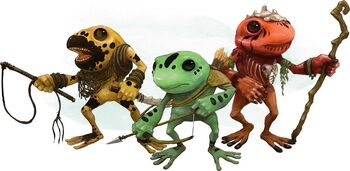
Grung
- 5.5E/5E: Small Humanoid; Lawful Evil; CR 1/4 (Grung), 2 (Elite Warrior), 1 (Wildling)
I dunno -- I've seen some people grumble that the Grung are just a more malicious version of the Bullywugs, or Lizardmen-but-in-frog-form, but I feel like the flavour is relatively well-written (if admittedly similar) and the artwork's pretty neat. I'm a fan.
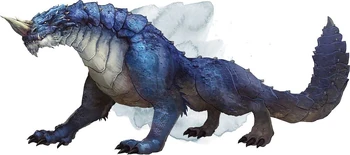
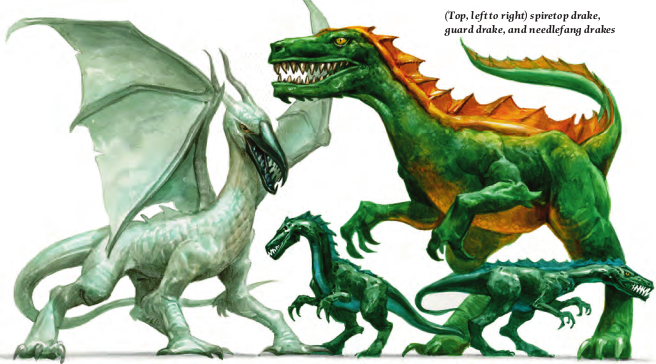
Guard Drake
- 5.5E/5E: Medium Dragon; Unaligned; CR 2
(The Guard Drake on that 4E artwork is the big, green, T-rex-esque one).
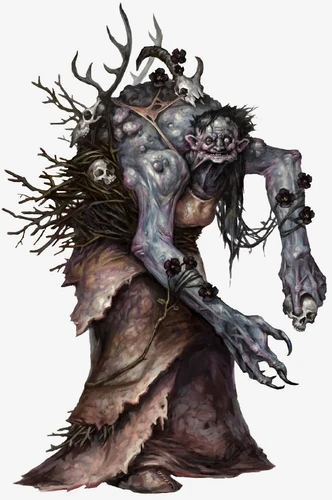
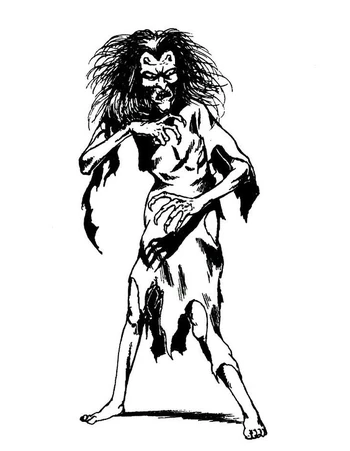
Hag: Annis Hag
- 5.5E/5E: Large Fey; Chaotic Evil; CR 6
Volo's also describes "Grandmother" and "Auntie" variants of all hag sub-types, noting that they are even more powerful and are extra-respected among Hag society due to their immense age and power. Also, we get the detail that hags can change their form from one to the other, depending on the individual hag's desires.
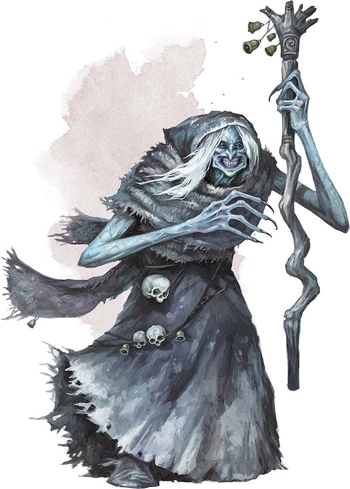
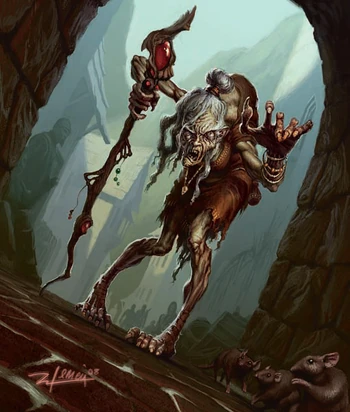
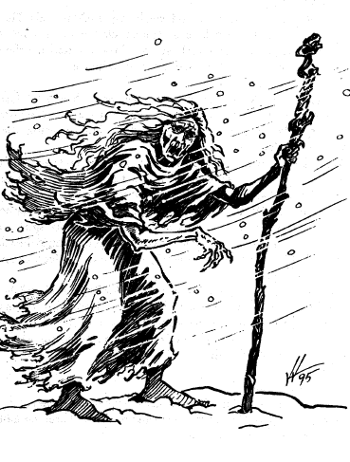
Hag: Bheur/Winter Hag
- 5.5E/5E: Medium Fey; Chaotic Evil; CR 7
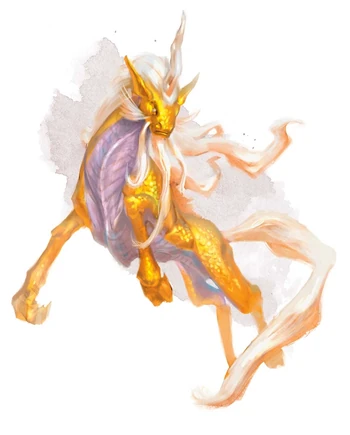
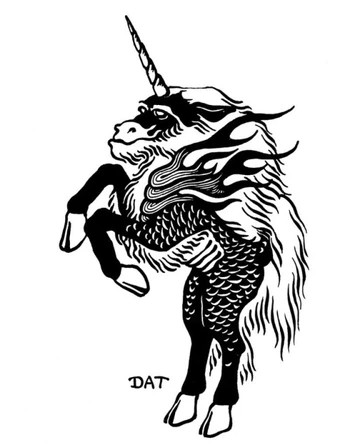
Ki-rin
- 5.5E/5E: Huge Celestial; Lawful Good; CR 12
While the appearance and depictions are relatively faithful to the original myths (and the Kirin was never really consistently depicted in real-life as well), a lot of their lore is a bit more vaguely defined. The 1E Kirin is noted to just be a race of aerial creatures that live in the clouds and winds, often showing up mostly to aid humans in fighting evil, and being mighty spellcasters -- which fit into the original myths of Kirins basically being an auspicious, holy sign. Most depictions of the Kirin in D&D tended to lean more towards the 'celestial horse-like creature' look as opposed to the sometimes dragon-inspired ones. I suppose it's to make dragons feel more unique or something?
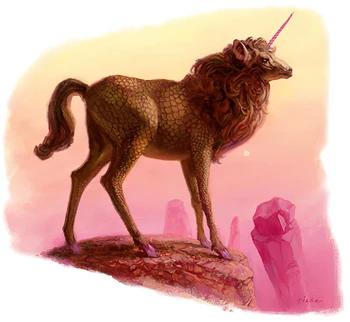 |
| Kirin (3E) |
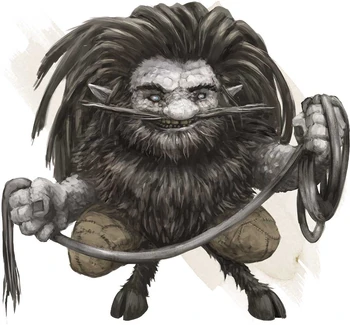
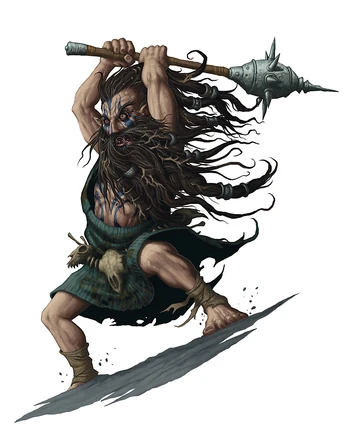
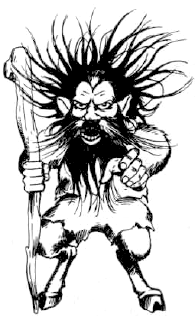
Korred
- 5.5E/5E: Small Fey; Chaotic Neutral; CR 7
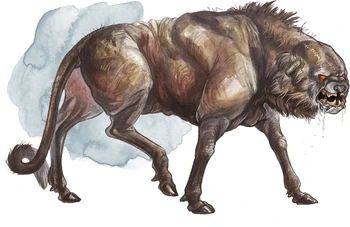
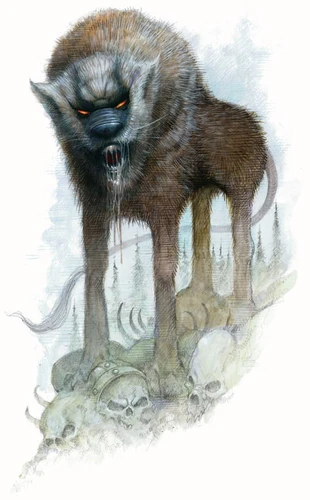
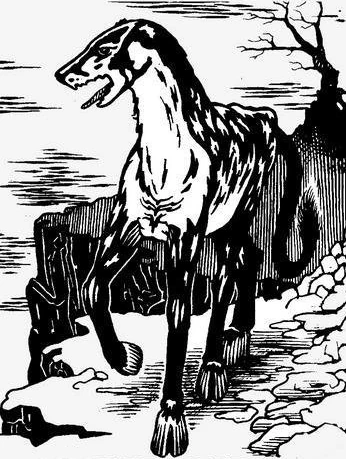
Leucrotta
- 5.5E/5E: Large Monstrosity; Chaotic Evil; CR 3
I'm not as familiar with the depiction of the Leucrotta in the 2nd and 3rd edition, but 5th edition throws in a couple extra horrid things into the mix -- the brain of the Leucrotta is apparently the brain of a sadistic cannibal, the body is now explicitly noted to come from a hyena and the ritual to create a Leucrotta is now tied to the gnoll demon god Yeenoghu, and sometimes, these were spontaneously created when hyenas are mutated by Yeenoghu's essence. The tie-in to Yeenoghu and gnolls is pretty neat, considering the fact that the mythological Crocotta/Leucrocotta is now recognized to be basically linked to hyenas. Leucrottas are rare, but they tend to sometimes show up in elevated positions among gnoll tribes, sort of becoming an adviser-cum-torturer. I feel like the 5th Edition artwork does lean more towards 'horrid hyena-human' moreso than a badger head, but the result does really sell the 'loathsome beast' vibe. There's also a bunch of new powers that the 5E Leucrotta has, including generally being nasty and foul, polluting everywhere it goes to, and having teeth made out of bony ridges. Overall, the 1E Leucrotta is interesting enough as a bizarre weird beast, and while I would've preferred that they let the Leucrotta still have its badger head, I do appreciate the little update that the 5th Edition offered it.
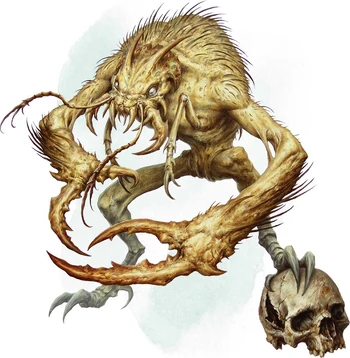
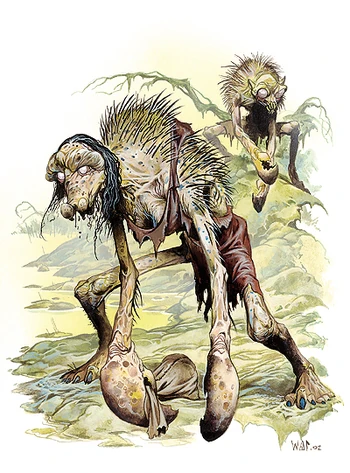
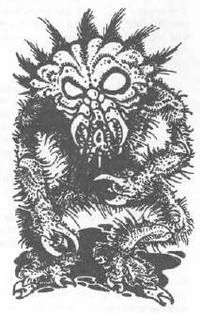
Meenlock
- 5.5E/5E: Small Fey; Neutral Evil; CR 2
The original 1E Meenlock was a creature who stalks a person who unknowingly disturbs their lair, eventually transforming them into a Meenlock through their hideous evil means. In 5E, the Meenlocks are fey born out of fear in the same vein that Boggles are born out of loneliness. They live in tunnel-like lairs in areas that are touched by the Feywilds, and those lairs apparently manifest spontaneously alongside the Meenlocks, and they just feel wrong to anyone who stumbles upon them. Just like their original counterparts, Meenlocks are able to teleport from shadow to shadow, and use a telepathic link to project spooky hallucinations into the minds of their chosen prey, explicitly picking unsettling visions like something darting just out of sight. As with most evil creatures in D&D, they are attracted to innocent souls, and they delight in kidnapping random people, then telepathically tormenting them until they succumb and transform into a Meenlock themselves. I kind of feel that I like the vibe of the original "unknown, telepathic stalker" vibe from 1E a lot more, but I do recognize that the Meenlock's subsequent retooling does make it a lot easier to run in a D&D setting.
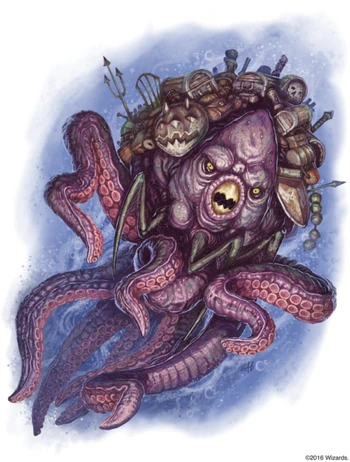
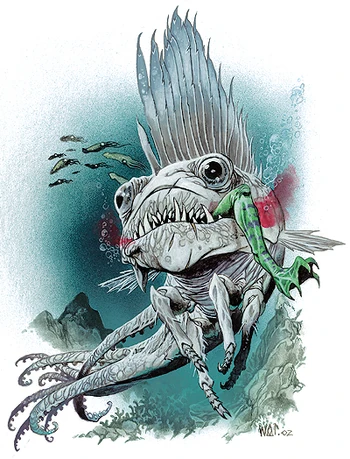
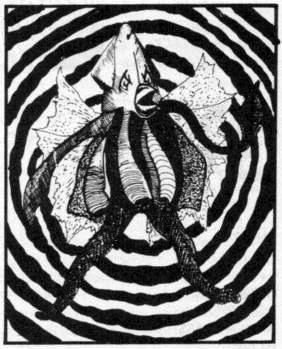
Morkoth
- 5.5E/5E: Medium Aberration; Chaotic Evil; CR 11
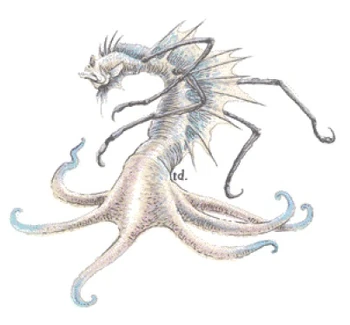 Interestingly, though, unlike some of the other abandoned 1E monsters, the Morkoth isn't just phased out or shuffled off as an easter egg in some obscure books in subsequent editions. No, the subsequent iterations of the game all tried their best to include the Morkoth in their core Monster Manuals. 2nd Edition scrapped the "squid-headed noddle man" and handwaved it as an erroneous description based on hypnotized eyewitnesses, and the 2nd edition Morkoth ended up being this awesomely gaunt-looking octopus-thing with a thin, bent spine that ended in the head of a deep-sea anglerfish or something, and four gangly bug-like hook-arms. Truly a cool-looking deep-sea horror that still has the lanky, goofy vibe of 1E. The 3rd Edition followed suit, although at first glance you'd be forgiven for thinking that 3E Morkoth is just an ugly fish. It's essentially the same design as the 2nd Edition one, but with some forced perspective, a larger angry-fish-head, a bunch of shorter shrimp-like bug legs, and the octopus part trailing off like a tail.
Interestingly, though, unlike some of the other abandoned 1E monsters, the Morkoth isn't just phased out or shuffled off as an easter egg in some obscure books in subsequent editions. No, the subsequent iterations of the game all tried their best to include the Morkoth in their core Monster Manuals. 2nd Edition scrapped the "squid-headed noddle man" and handwaved it as an erroneous description based on hypnotized eyewitnesses, and the 2nd edition Morkoth ended up being this awesomely gaunt-looking octopus-thing with a thin, bent spine that ended in the head of a deep-sea anglerfish or something, and four gangly bug-like hook-arms. Truly a cool-looking deep-sea horror that still has the lanky, goofy vibe of 1E. The 3rd Edition followed suit, although at first glance you'd be forgiven for thinking that 3E Morkoth is just an ugly fish. It's essentially the same design as the 2nd Edition one, but with some forced perspective, a larger angry-fish-head, a bunch of shorter shrimp-like bug legs, and the octopus part trailing off like a tail.5th Edition gave us an interesting take on the Morkoth, and even gave the Morkoths a gloriously over-the-top origin story. Morkoths are apparently ancient beings that travel from plane to plane, "born out of the petrified husk of a deity of greed and sprite", forming the squid-faced octopus creatures that are the Morkoths. And I could see the inspiration they took, borrowing the 1E Morkoth's goofy beak-face (which now actually does look like a squid's beak) and the octopus tentacles and bug-legs combo of the 2E and 3E versions. But instead of a mere lair where the shape of the tunnels will hypnotize their prey, 5E Morkoths now lair in straight-up extra-planar dream-scape islands where their prey go straight through some Alice in Wonderland madness. Morkoths can control these islands to move around from plane to plane, picking bizarre things from different planes or periods in time, and honestly that's just a recipe to make some pretty wacky, unsettling self-contained dungeon islands. The Morkoths are hoarders that are driven to gain whatever they don't possess, which is shown in 5E's artwork as having the upper part of its body clustered with random chunks of treasure. that probably can't be good for the Morkoth's back. It's a pretty interesting concept for a creature for sure, and makes the Morkoth super-duper badass and bizarre, and now they're these weird dimension-travelling hoarders who just happen to look like wacky octopus-creatures. I do like the update from just a weird hypnotizing labyrinth into a weird, strange landscape and the hypnosis being an innate part of the Morkoth itself. Perhaps not the most faithful update, but I'm growing to kind of like this weird space-octopus with a treasure hoard backpack.

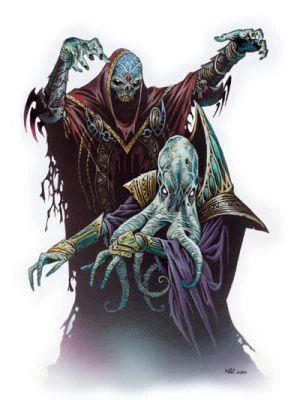
Mind Flayer: Alhoon (& Illithilich)
- 5.5E/5E: Medium Undead; Any Evil; CR 10
- 5E: Medium Medium; Any Evil; CR 22
I do love the artwork for both the 3E and 5E versions of the Alhoons, which really does a great job at keeping the standard design of a Mind Flayer, but making the tentacles and face look so dessicated and dried-out, a neat way to showcase an undead but not rotting octopus person. The prose notes that Alhoons are difficult to visibly distinguish from a regular illithid if you don't know what to look for. The Alhoons also have unique features unlike any other lich, returning into a hivemind of Alhoon minds in the Periapt if their body was destroyed. They also extend their life not by the quantity of souls they consume, but they extend their lives by the age of the person they sacrificed... so long-lived beings like elves and halflings are probably #1 on the Alhoon soul food menu. Volo's also describes the Illithilich, or Mind Flayer Lich if you don't want to bite your tongue while saying the name, where a Mind Flayer actually goes through the proper way of becoming a lich with the mastery of arcane magic, a fancy phylactery and everything, a creature that's significantly more powerful. I think in most previous editions, though, the two terms are used interchangeably. Ultimately, I do find it interesting that despite introducing a more powerful version of the Mind Flayer, they're intentionally meant to be rival antagonists to the regular Mind Flayer package, whose 'big boss' enemy is...
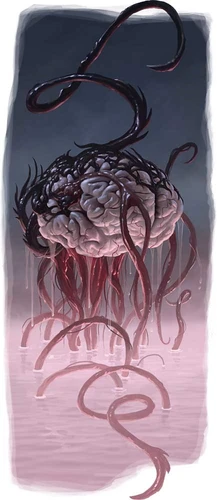
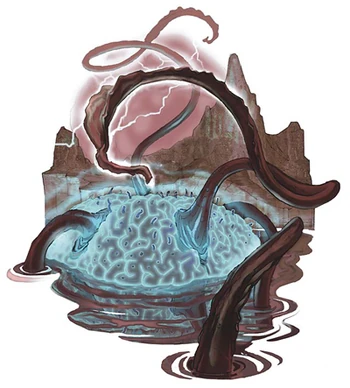
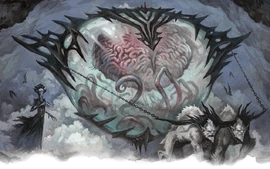
Mind Flayer: Elder Brain
- 5.5E/5E: Large Aberration; Lawful Evil; CR 14
Anyway, the Elder Brain in 5E is described to reside in the center of any Mind Flayer city, stretching out with its mighty telepathic/psionic powers and maintaining a connection with all the Mind Flayers in its colony, quite literally being the 'brain' of the body that the colony forms. It can also rewrite the thoughts of non-Illithid minds around it, able to essentially make them see and feel what the Elder Brain wants them to see and feel. For more long-term, insidious plans, the Elder Brain can reach very far and implant suggestions as dreams to influence other non-Illithid minds. And if more subtle means of manipulation fails to work, there's good old Dominate Person, and if that fails, the Elder Brain can just utterly break the dude's mind with surges of psychic energy. The Elder Brain also feeds, eating the brains of other creatures, and when other Illithids die, their brains are devoured by the Elder Brain so that they may join into the unified thoughts and minds of the Elder Brain. While the Elder Brain is technically its own entity (and their personalities differ, with the only thing in common being that the Elder Brain has one hell of an ego problem), it may draw out the specific persona of any individual Illithid that's been consumed by it. Ultimately, a pretty damn awesome part of the Mind Flayer lore that both serves as a pretty cool boss-type enemy, as well as a pretty thematically appropriate leader.
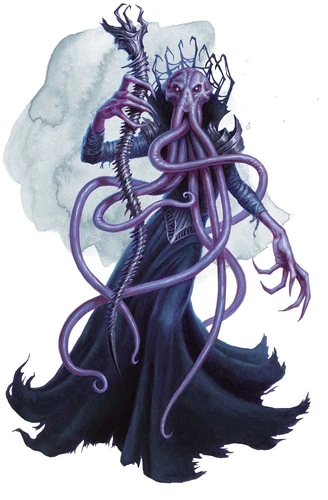
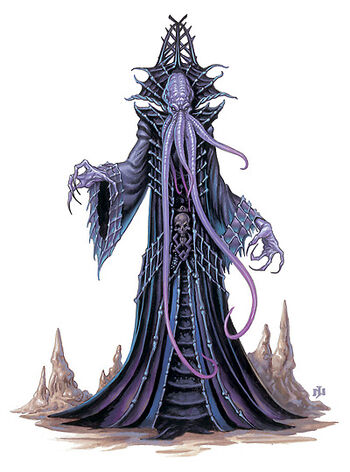
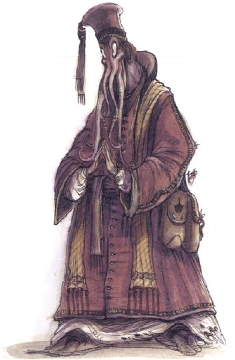
Mind Flayer: Ulitharid
- 5.5E/5E: Large Aberration; Lawful Evil; CR 9
And why are Elder Brains a bit afraid of Ulitharids? Well, because... where do you think Elder Brains come from? Ulitharids is a stage in the Illithid's strange, strange life cycle, and Ulitharids that died will have their brain grow into an Elder Brain if the conditions are right. Basically, Ulitharids have to sort of choose to become Elder Brains, by cracking open their skulls with their staves, and then its servitors will transport the brain to a brain pool, mixed with the ichor from the Ulitharid's body. Ultimately, I do like this. The Mind Flayers have sort of an ant-colony feel to them, with the Elder Brain sort of being the queen, and the Ulitharids are, I suppose, drones or pre-colony queens.
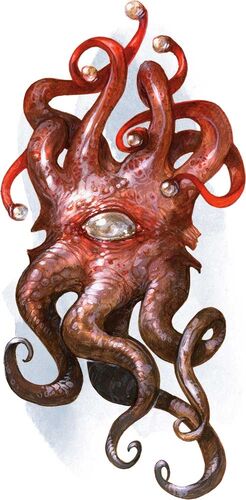
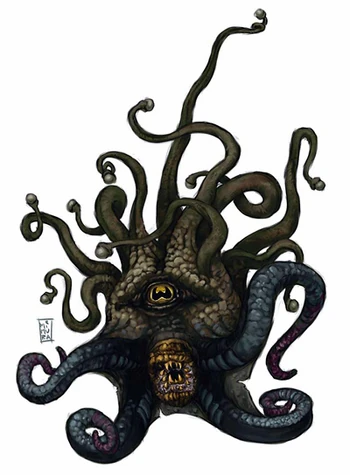
Mindwitness
- 5.5E/5E: Large Aberration; Lawful Evil; CR 5
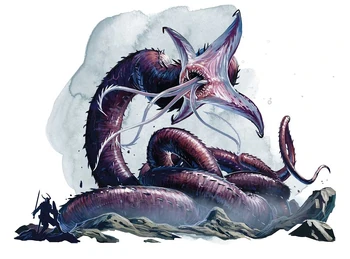
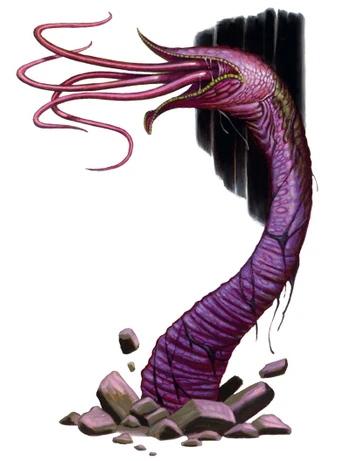
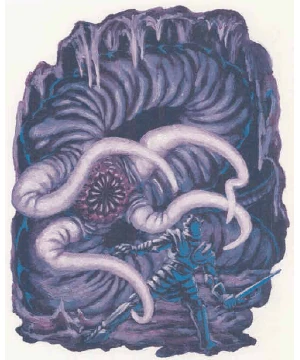
Neothelid
- 5.5E/5E: Gargantuan Aberration; Chaotic Evil; CR 13
The Neothelids themselves are utterly savage, having minimal, almost animal-like intelligence, but also equipped with mighty psychic abilities, the equivalent of giving a child super-powers. They basically charge through the Underdark with the sole desire to feed their hunger, and they also spit tissue-dissolving enzymes to reduce all parts of any humanoid victim into slime, leaving behind only the brain. What a hilariously B-movie ability to have! The Elder Brains fear the Neothelids, because the Neothelids are so dumb that the Elder Brain can't sense it, but the Neothelids themselves don't really know that they have any sort of link to Illithid society. Ultimately, a pretty freaking cool giant worm monster. I know we already have a Purple Worm, but there's enough space in the Underdark to have two giant, horrifying people-eating worms, one that just gulps you alive and one that has a nasty lamprey-mouth that melts your flesh and eats your brain.
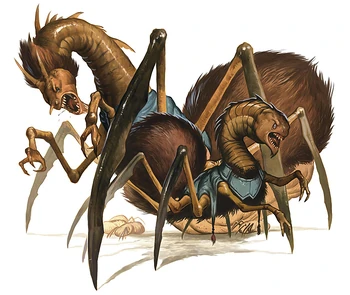
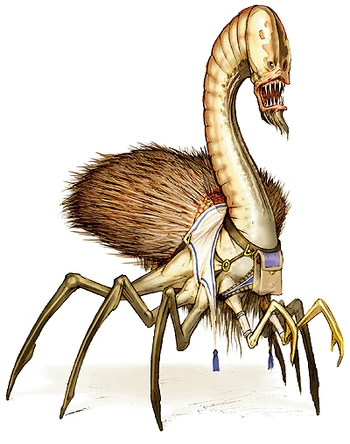
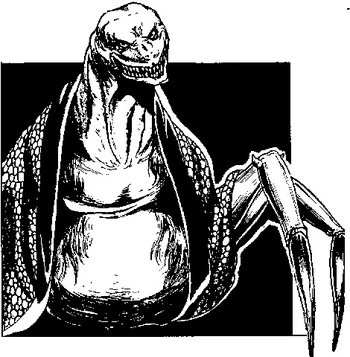
Neogi
- 5.5E/5E: Tiny Aberration; Lawful Evil; CR 1/8 (Hatchling)
- 5.5E/5E: Small Aberration; Lawful Evil; CR 3 (Neogi)
- 5.5E/5E: Medium Aberration; Lawful Evil; CR 4 (Neogi Master)
More interesting to me about the Neogi, of course, is their hilarious world-view, which I've seen someone compare to basically an 18th-century aristocrat obsessed with hierarchy. Being born with mind-controlling powers, the Neogi view it as a way of life and almost appropriate, and they end up being another one of those alien creatures in D&D who just don't get emotions and individuality. They don't do so out of malice or pragmatism, however, they just straight up are unable to comprehend non-Neogi reasoning, and all of their culture depends on the ability to control others. The more powerful control the more weak, and so on. When they are born, they live under the control of adult Neogi, and then they have to earn their place in their society by dominating other creatures, and they try their best to reach as high of a rank as they can, while kowtowing to Neogis of greater station. Eventually, when the Neogi's about to die, the elder Neogi would be swarmed by the rest of its group, inject it with poison, and transform it into a bloated flesh mass called a 'Great Old Master', which would later be used as something for the rest of the hive to lay eggs upon, and the great old master would become food for the hatchlings. When dealing with other non-Neogi, they basically pose as sleazy salesmen, selling and buying and trying to eke out as heavy of a profit as they can, while also at the same time trying to enslave their patrons. We get an interesting description of Neogi caravans and traders showing up to sell their wares (i.e. slaves) to drow, mind flayers or in 'planar bazaars, but their reputation tends to invite actual fighting more than not. I kinda wished that Volo's had spent more time describing their bizarre greedy space slave-merchant culture more than their life cycle, though. I like them. They're so fukken weird.
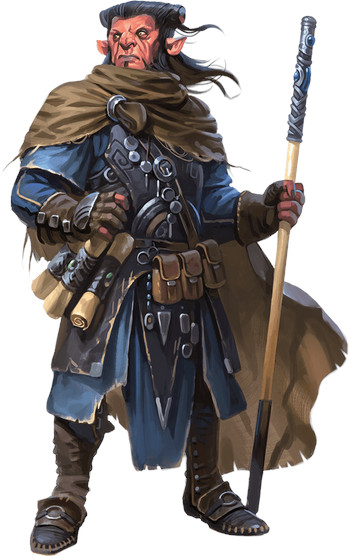
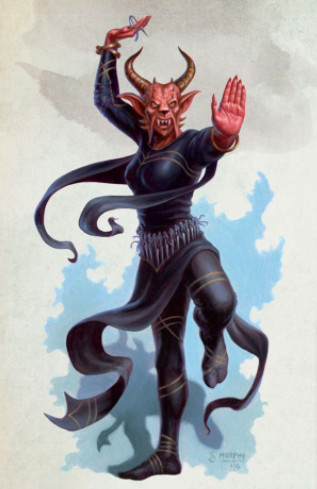
Hobgoblins
- 5.5E/5E: Medium Humanoid; Lawful Evil; CR 4 (Devastator), 2 (Iron Shadow)
The Hobgoblins, like their goblin cousins, get a sub-chapter to themselves in Volo's, and we get two elite Hobgoblins out of it. I actually do like the depiction of the Hobgoblins as a far more martial and organized society, even if the 5th Edition artwork doesn't really scream 'goblin' for me. Hell, show me that picture of the Iron Shadow and I'd probably call her a weird tiefling or something as opposed to a hobgoblin, y'know? (I know, that's a mask designed to resemble a devil, but still...)
Anyway, the Hobgoblin Devastator are essentially the Hobgoblin society's version of wizards, and any hobgoblin with a talent for magic is called into study at the Academy of Devastation, turning them into specifically war-wizards -- they know how to cast fireballs, but they don't know the theory... but really, they're a war-like race. Of course they have no need for the theory. The prose notes how different hobgoblin culture is in making their wizards fight in combat as opposed to being 'cloistered scholars', but really, even without counting adventurers, surely wizards that wade into combat in D&D is the rule rather than the exception? The Hobgoblin Iron Shadow is, in contrast hobgoblin monks, who also double as secret police, scouts and assassins. So monk-rogues, then? They essentially become the secret spy society among massive Hobgoblin communities, and they are fanatically loyal to the goblin god Maglubiyet, and the Iron Shadows essentially enforce this rule heavily in hunting down treacherous goblins and whatnot. This could actually serve as a neat little plot hook if your setting has a rogue goblinoid character (or even an entire non-evil goblinoid village), because suddenly they have displeased their god, and now an entire society of secret police monks are out to murder your hobgoblin PC.
Anyway, the Hobgoblin Devastator are essentially the Hobgoblin society's version of wizards, and any hobgoblin with a talent for magic is called into study at the Academy of Devastation, turning them into specifically war-wizards -- they know how to cast fireballs, but they don't know the theory... but really, they're a war-like race. Of course they have no need for the theory. The prose notes how different hobgoblin culture is in making their wizards fight in combat as opposed to being 'cloistered scholars', but really, even without counting adventurers, surely wizards that wade into combat in D&D is the rule rather than the exception? The Hobgoblin Iron Shadow is, in contrast hobgoblin monks, who also double as secret police, scouts and assassins. So monk-rogues, then? They essentially become the secret spy society among massive Hobgoblin communities, and they are fanatically loyal to the goblin god Maglubiyet, and the Iron Shadows essentially enforce this rule heavily in hunting down treacherous goblins and whatnot. This could actually serve as a neat little plot hook if your setting has a rogue goblinoid character (or even an entire non-evil goblinoid village), because suddenly they have displeased their god, and now an entire society of secret police monks are out to murder your hobgoblin PC.


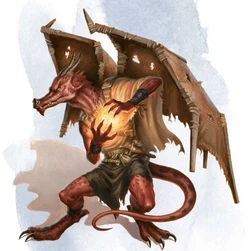
Kobolds
- 5.5E/5E: Small Humanoid; Lawful Evil; CR 1 (Dragonshield), 1/4 (Inventor), 1 (Scale Sorcerer)
Kobolds kobolds kobolds! In addition to a lot of fun little details about how kobold society functions, Volo's adds three elite kobolds. The first is the Kobold Dragonshield, who... uh... is kinda boring. He's just a strong, distinguished warrior, selected by a kobold clan's dragon master to undergo special training so they can guard the dragon's eggs. They have shields made out of dragon hearts, and have some heavy, heavy impostor syndrome and thus are extra-desperate to prove that they are worth their status. The Kobold Inventor is my favourite out of these three, mostly due to the hilarious set of contraptions it's got attached to it. Clearly meant to be more comical than serious, the Kobold Inventor makes bizarre Wile E. Coyote contraptions out junk and random scavenged materials, which... somehow works. Maybe the bizarre Quipper-launcher 2000 works exactly for one shot, but sometimes one shot is what you need, y'know? And even if the Inventor blows up his own face, that's a distraction for the rest of the clan.
The Inventor might be my favourite thematically, but the Kobold Scale Sorcerer has my vote for favourite artwork. Look at those tattered fake dragon wings! Look at how pleased the Kobold is to be cosplaying as a dragon! Scale Sorcerers are essentially Kobold spellcasters, and we also get the lore that the Kobolds' actual deity is imprisoned (is that why they worship dragons?) and they have no access to clerics, so the Scale Sorcerers end up filling the role of fireball-launcher, negotiator-to-their-dragon-overlord, historian and advisor.
The Inventor might be my favourite thematically, but the Kobold Scale Sorcerer has my vote for favourite artwork. Look at those tattered fake dragon wings! Look at how pleased the Kobold is to be cosplaying as a dragon! Scale Sorcerers are essentially Kobold spellcasters, and we also get the lore that the Kobolds' actual deity is imprisoned (is that why they worship dragons?) and they have no access to clerics, so the Scale Sorcerers end up filling the role of fireball-launcher, negotiator-to-their-dragon-overlord, historian and advisor.
The 5E stats of the creatures covered here:
- Girallon: Large monstrosity; unaligned; CR 4
- Grung: Small humanoid - grung; lawful evil; CR 1/4
- Grung Elite Warrior: Small humanoid - grung; lawful evil; CR 2
- Grung Wildling: Small humanoid - grung; lawful evil; CR 1
- Guard Drake: Medium dragon; unaligned; CR 2
- Annis Hag: Medium fey; chaotic evil; CR 6
- Bheur Hag: Medium fey; chaotic evil; CR 7
- Hobgoblin Devastator: Medium humanoid - goblinoid; lawful evil; CR 4
- Hobgoblin Iron Shadow: Medium humanoid - goblinoid; lawful evil; CR 2
- Ki-rin: Huge celestial; lawful good; CR 12
- Kobold Dragonshield: Small humanoid - kobold; lawful evil; CR 1
- Kobold Inventor: Small humanoid - kobold; lawful evil; CR 1/4
- Kobold Scale Sorcerer: Small humanoid - kobold; lawful evil; CR 1
- Korred: Small fey; chaotic neutral; CR 7
- Leucrotta: Large monstrosity; chaotic evil; CR 3
- Meenlock: Small fey; neutral evil; CR 2
- Alhoon: Medium undead; any evil alignment; CR 10
- Illithilich: Medium undead - lich mind flayer; any evil alignment; CR 22
- Elder Brain: Large aberration; lawful evil; CR 14
- Ulitharid: Large aberration; lawful evil; CR 9
- Mindwitness: Large aberration; lawful evil; CR 5
- Morkoth: Medium aberration; chaotic evil; CR 11
- Neogi Hatchling: Tiny aberration; lawful evil; CR 1/8
- Neogi: Small aberration; lawful evil; CR 3
- Neogi Master: Medium aberration; lawful evil; CR 4
- Neothelid: Gargantuan aberration; chaotic evil; CR 13
No comments:
Post a Comment